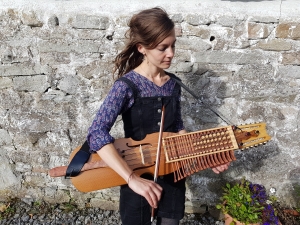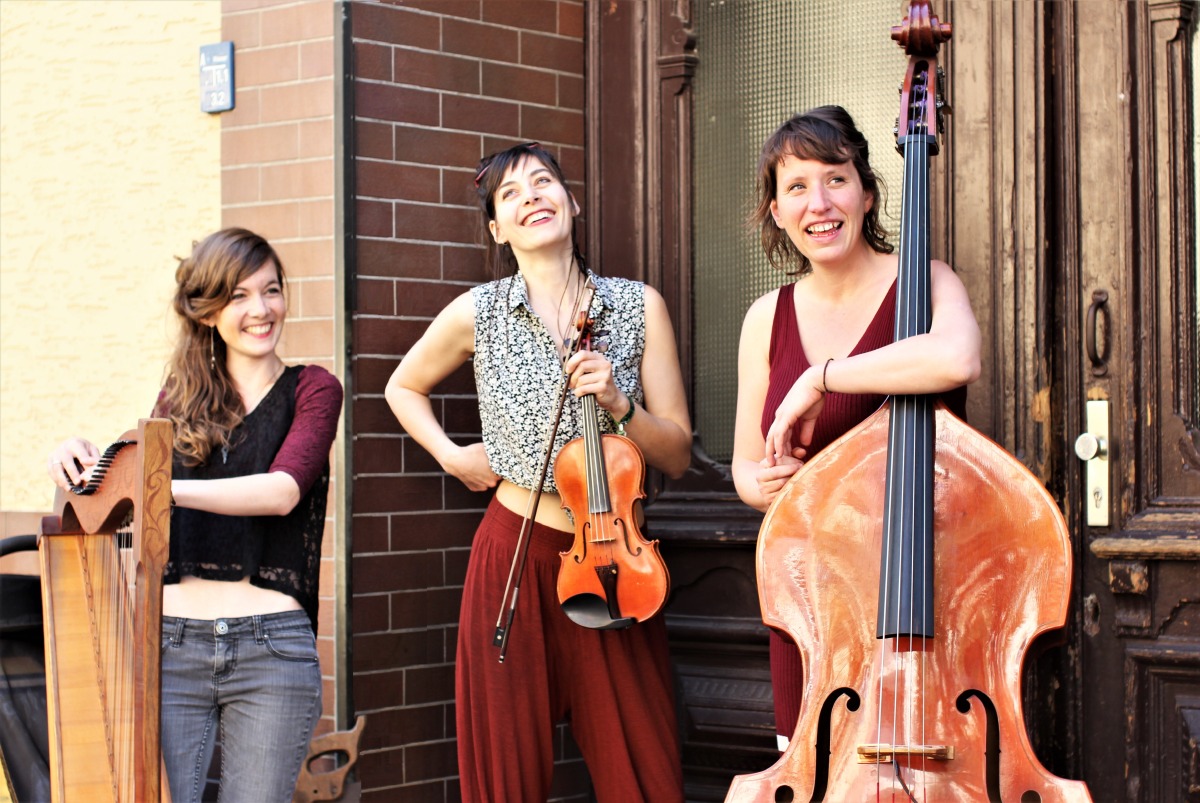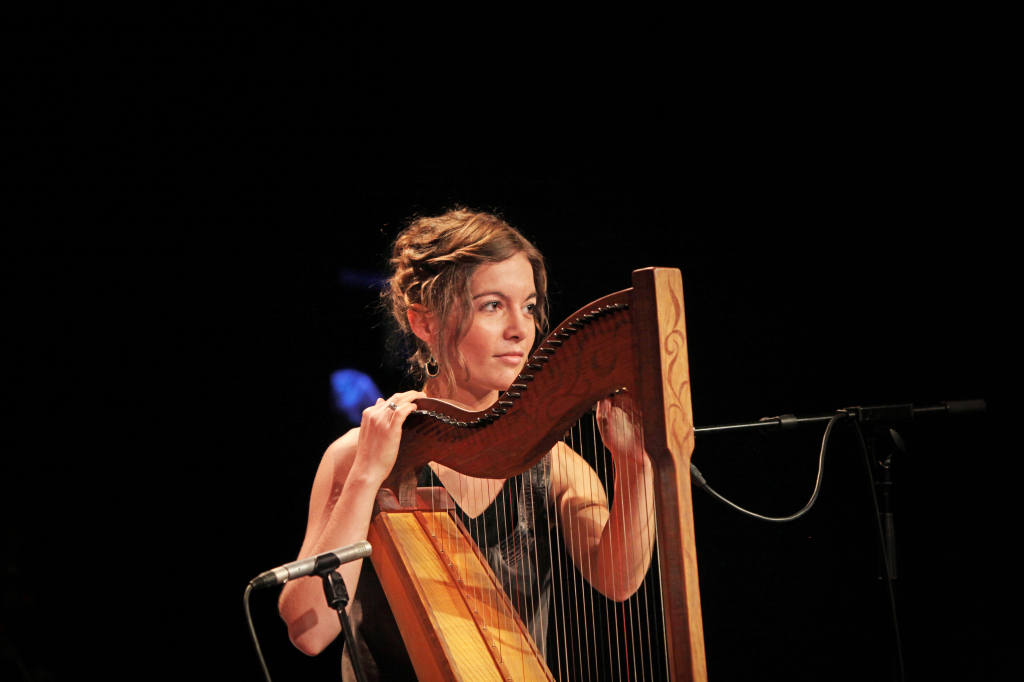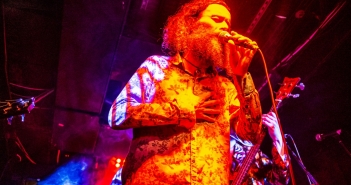When I was five, I made myself a paper flute. I played it sitting on a stone in the Danish summer. My parents later gave me a real flute and I played it fervently until my teacher said it was time I learned some more instruments. I didn‘t consider myself a musician. I just loved to play.
My main instrument today is the harp, but it took me a while. Living near the Alps, it should have been easy. Alpine music is full of string instruments. But I played the flute, and loved folk music which was not from Germany. I didn‘t know at that point how fine German folk music can be. I thought Volksmusik was a lot about brass, and yodeling, and mostly for loud men in leather pants.
Growing up in the Catholic Bavarian countryside can be an ambivalent experience. Like singing in the local church band while dreaming of travelling with a circus. My first idea for a future profession was to be a woodturner, or a carpenter, which earned me comments like, girls should not work as carpenters. This was in the 1990s.
One day, I learned about an instrument maker in the region who taught people how to build historical harps by themselves. I was thrilled. This is how it started. I participated without being able to play one note on my new harp. In my head, making it came first.
This self-made, improvised kind of doing things is a quality I like a lot about folk music. Generally, about this thing called Kleinkunst in German, small art. In the beginning, there often is just the longing to play. A tiny stage, a handful of people, you did‘t even plan it, and suddenly, there is magic in the air. Like in a song by the Portuguese band Deolinda:
He passed and smiled at me and all of a sudden, the ugly face of the town changed, everything was covered in flowers … what would happen if we talked to each other?
Passou por mim e sorriu (gerda vejle):
Travelling musician
What qualifies you to be an artist? If you make a living of it? Or is it a particular way to be in the world? If you manage to transform the ordinary into beauty? Tell a story in a manner that opens a new perspective on the world, which others can relate to?
For me, it has to do with connecting. Connecting people, places and perspectives. I play a harp model called Bohemian Harp. It is neither a Celtic nor a classical harp. It is an instrument of travelling people, linked to the tradition of travelling dance musicians. Especially in the nineteenth century, there were small orchestras of Bohemian harp players, often women, who though poor managed to make an autonomous living by playing music travelling from place to place.
I too had been travelling for some time when I arrived in Berlin, a place of many perspectives and travelling existences. Studying music therapy there and later with fantastic harp player and teacher Uschi Laar, I learned something important: That music is not something you show off. Music can be something that saves you. Sometimes it is the only continuity you have. It can give voice to the unspoken, transform depth into lightness. And it has a great inclusive power.
I then met a storyteller, Ana Rhukiz. We started a travelling duo project, performing barefoot under the open sky, in tiny villages, on smaller and bigger stages, for young and old, few and many. We connected composition and performance, art and nature. What I like about fairy tales is that they often transport a hidden wisdom over time. One piece was about making rain. Drought had fallen upon humanity because nature had been disrespected. During the piece we would say the rain spell together with the audience. Often, it would rain for real, even on a sunny day.
The Lucky Accident
One element of improvisation is accident. And, at the right moment, Kairos.
Do you know Kairos? The Greek God of the lucky accident. A harp maker in Berlin told me the story of Kairos: he has just one hair and is fast. When he passes your way, you have to be lucky to grasp him at his one hair before the moment is gone.
Meeting violinist Judith Retzlik might have been one such moment of Kairos: I had placed one single note on a black board at university saying I was a harp player looking for other musicians. Our band was completed by double bass player Anne Drees, who gave the warm grounding to our violin, harp and voices improvisation. We named ourselves gerda vejle.
In concerts, people ask: Who of you is Gerda? And we smile and say: all of us. Gerda is an imaginative woman. She is creative. She might change her identity now and then. She loves to try out new things, be it styles or genres. She certainly is a feminist.
Over time, gerda has grown. She was drawn to idyllic and disastrous moments at the beginning. Much of heartbreak and rebellion. More themes arouse over time. Less drama, more questions. More laughing also. We made and discovered more instruments. The nyckelharpa, the trumpet, the ukulele. We sing in many languages, merging songs, mostly unplugged. I moved to Austria for some time, the yodeling came back to me from childhood days. I am not a great yodelist. It is a fun way to give credit to something that belongs to me without taking it too seriously.

The Layers Beneath, and Beyond
Gerda vejle is also often asked: Are you a cover band? And in fact, we play mostly songs that already exist. In the beginning, I had the ethos that we should be making our own tunes. But nowadays I would say I proudly cover. In folk music, like in oral tradition, the origin of a tune cannot always be figured out. And many true stories have been truly told before you entered stage. What gerda vejle is doing is collecting them, retelling them, giving her own voices and character to them.
What I learned when I studied literature and ever more working with storytellers is that very text, be it written or spoken, is woven from other texts. Likewise, music is a texture of relations and worlds. It is a vibrant body with many layers under the surface. Folk pieces never get finished. You just keep on crafting them over and over again.
Making music feels like exploring these layers by time. I seldom seek for ideas with a plan. They are hidden in the music, and sometimes quite somewhere else.
With the pandemic and other crises, I am asking myself more questions. What is the role art should play in a time of transformation? Which responsibility falls upon artists when there is so much confusion, and where values are challenged and resources running scarce? Should art be more political, and if so, in which way? Or could artists become people you turn to in confusion, as they often have lived through confusion and hardship themselves? For me, art is not something you add to your life when everything else is fixed. Rather, it is something that can give you another perspective to look at during bumpy times, a bit like humour.
So, one idea I found so far: there should be lightness in the heaviness. Thus, never forget the playfulness. When I teach music, I try to remind people they can be playful. I don‘t believe in the unmusical child. I believe everyone can enjoy creativity. You have to find the language. And a way to play around the bumpiness. Make a song of it. Make it fly.

Gerda vejle – image by Juliette Cellier
Coming to Ireland soon: gerda vejle in concert
Friday Sept 22th, 2023 – Clonskeagh Castle, Dublin
Saturday Sept 23rd, 2023 – Yeats Society, Sligo
Links:
Music and writing: www.wanderharfe.de
Building a Bohemian harp: www.klangwerkstatt.de
Featured Image: TEDxDresden2016




